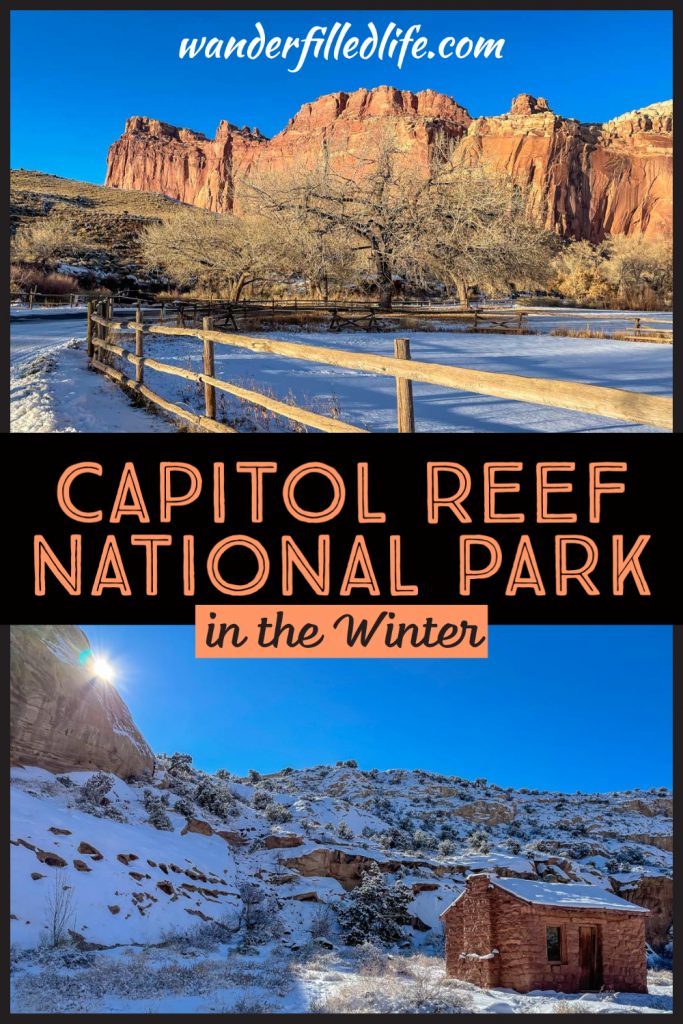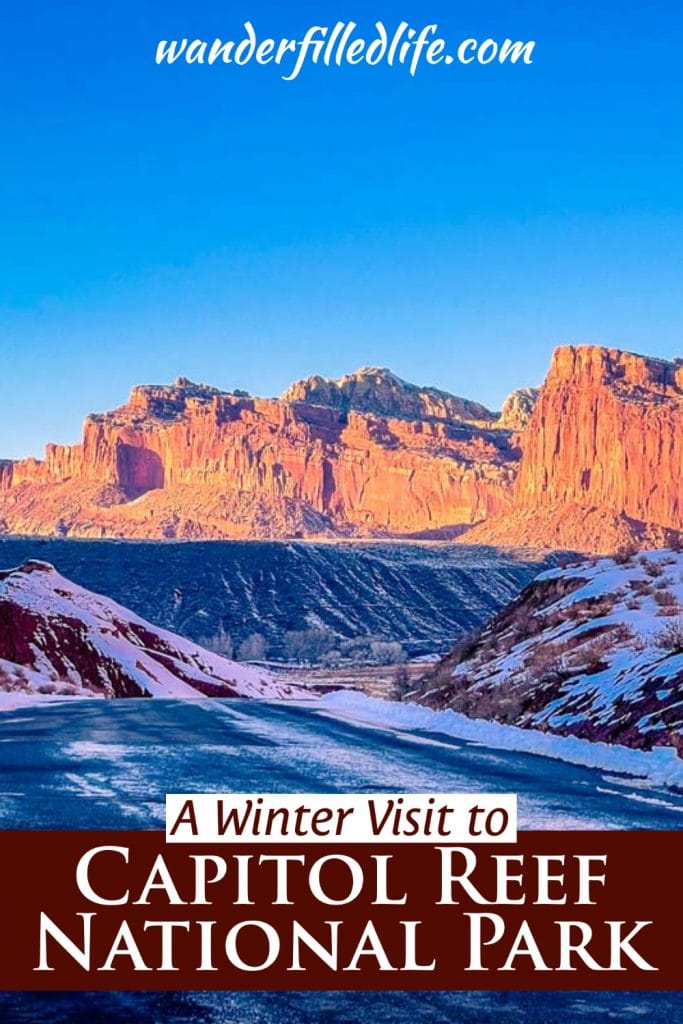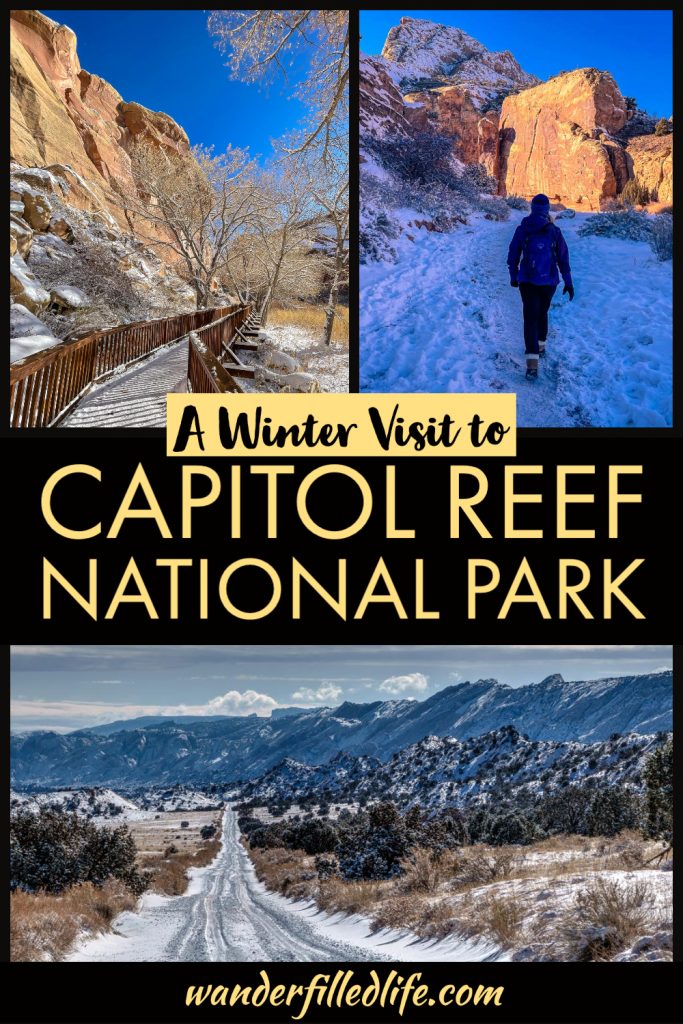Last Updated on February 20, 2024 by Grant
Visiting Capitol Reef National Park in the winter gives you a stark contrast: beautiful red sandstone cliffs occasionally coated in snow. It also offers fewer crowds and milder temperatures than the rest of the year.
We got “lucky” that Capitol Reef National Park got snow just before we visited. Unfortunately, that snow did temporarily close the Scenic Drive. Still, we were still able to enjoy most of the park and get out on the trail.
According to the Park Service, the park got its name from early settlers who named cliff areas “reefs” because they were serious obstacles to transportation. The park has several white domes, which reminded these settlers of the Capitol in Washington, DC. Hence, Capitol Reef National Park.
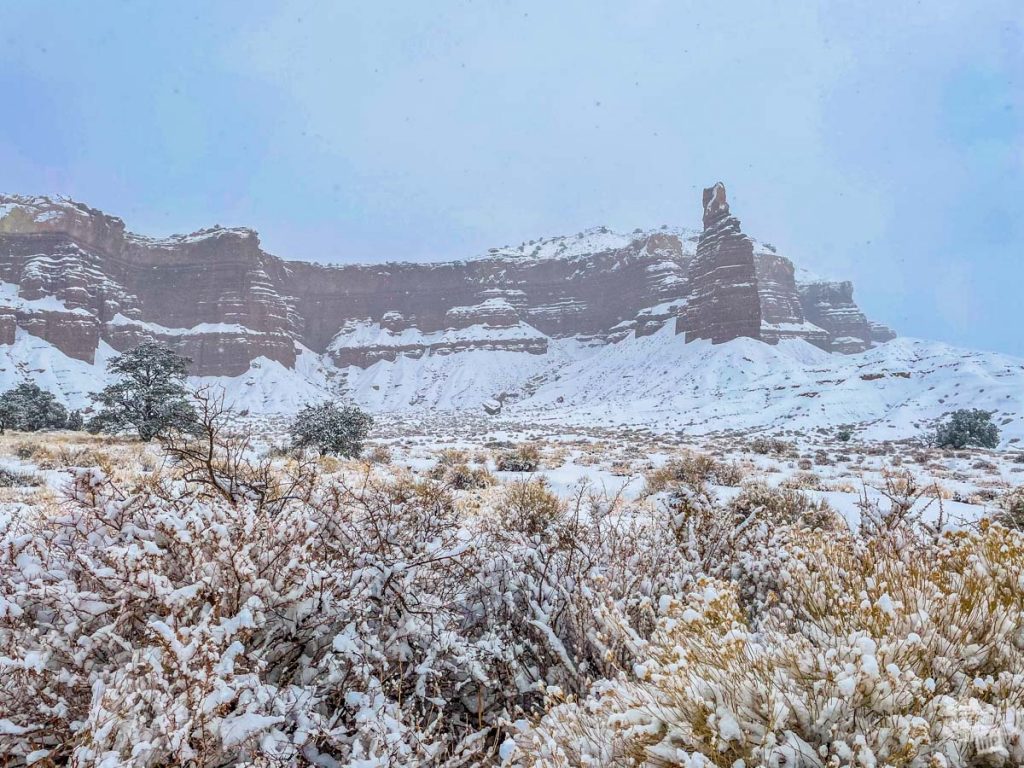
(Disclaimer: When we link to places where you can buy our stuff or places we stayed, we are using special codes that earn us commissions on the sales at no additional cost to you. Please see our Review Policy for more information.)
What to do at Capitol Reef National Park in the Winter
Visitor Center
As always, your first stop should be at the visitor center in the Fruita Historic District. Check out the exhibits and speak to the rangers about conditions in the park. Most of the time, the area is quite dry. Wet conditions, like snow or rain, can make for difficult travels on any of the trails or unimproved roads.
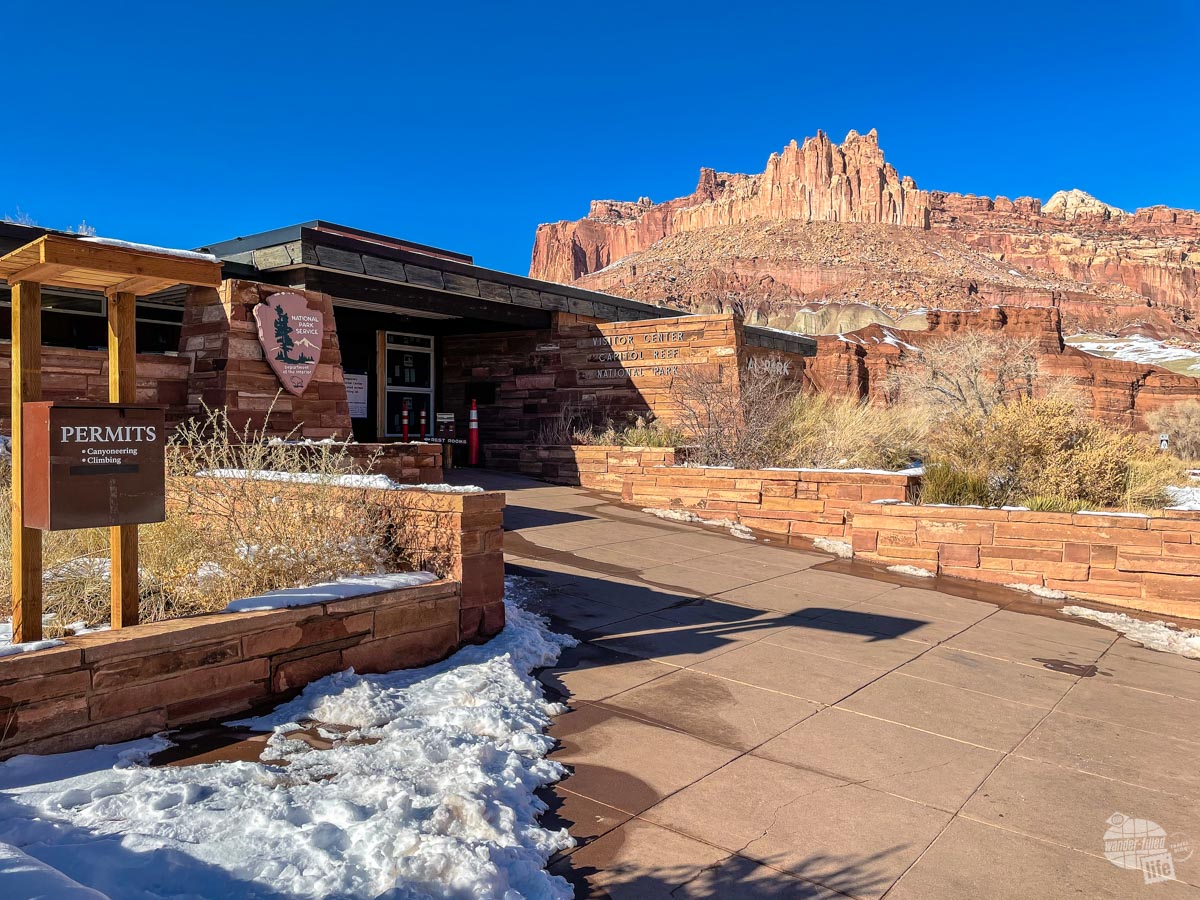
When we visited Capitol Reef in the winter of 2020, the main visitor center was closed for renovations. The Park Service had a temporary building open with rangers to answer questions and a limited park bookstore. We were able to get info on hikes and driving the Notom-Bullfrog Road.
Explore the Fruita Historic District
Fruita was a small community, never more than 10 families, at the junction of Sulphur Creek and Fremont River nestled in a gap of the Capitol Reef. It was settled around 1880 by Mormon settlers.
Using the water from the Fremont River, these settlers were able to farm the land, planting fruit orchards and grazing livestock. The are several structures still standing, including the blacksmith shop, the schoolhouse and the famous Gifford House.
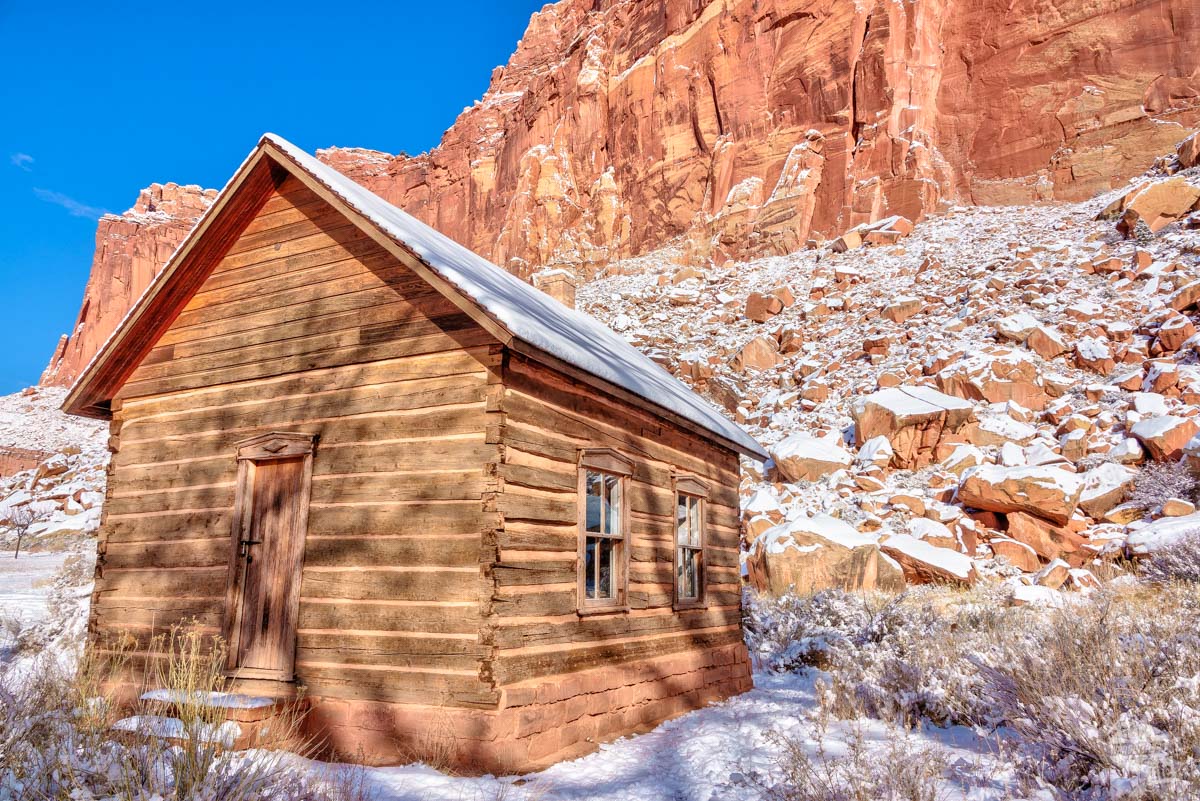
As teachers, we love seeing old schools and this one did not disappoint. It’s a one-room schoolhouse on land donated by one of the Behunin family, who raised 13 children of their own in the community. Indeed, one of their daughters became the first teacher at age 12. She taught three of her own siblings as well as 19 other students of all ages.
The school taught grades 1-8 in the same room, and the students primarily learned the “three Rs:” reading, writing and arithmetic. As the school acquired textbooks and the teacher gained experience, other subjects were added.
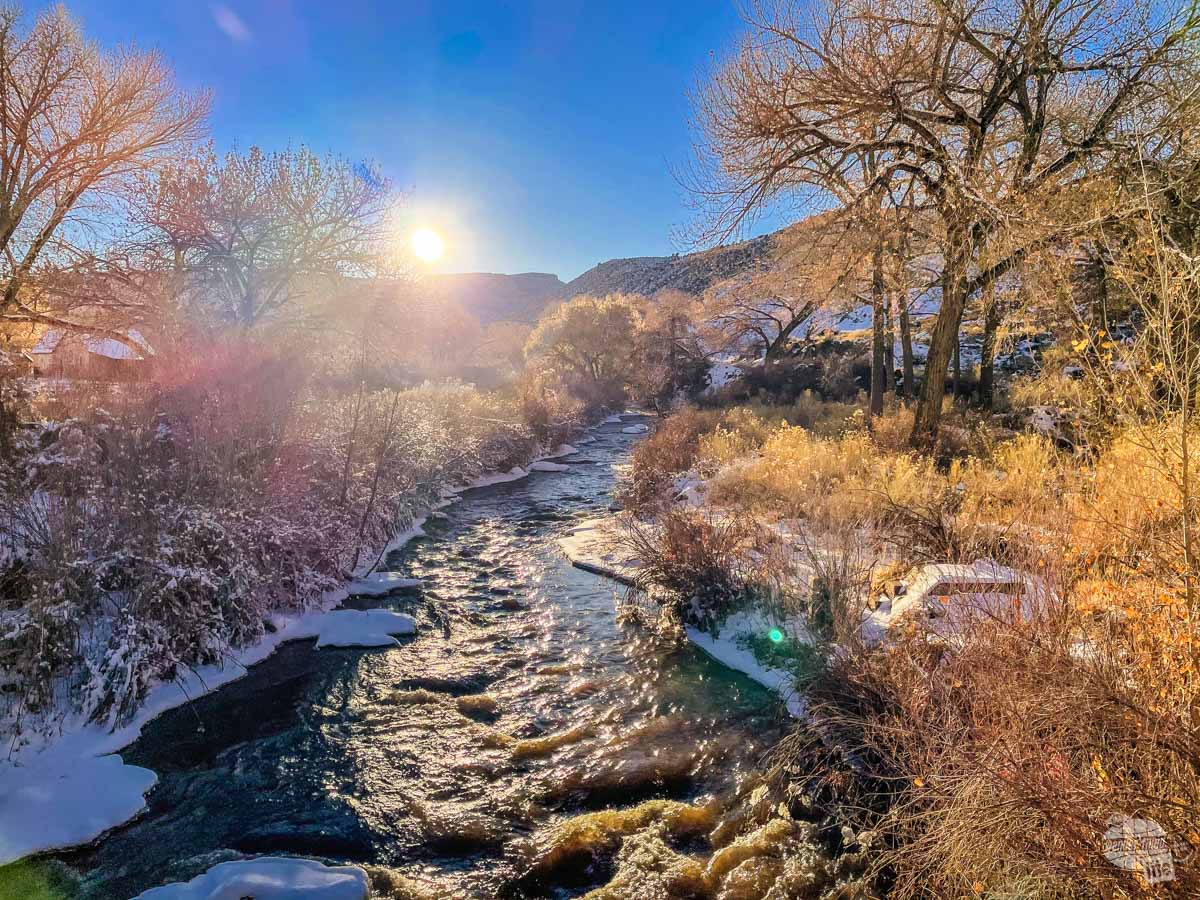
On the other side of the Fremont River just down the Scenic Drive is the Gifford Homestead, which was a farm and ranch in the area. The Park Service preserved the house as an example of a typical Mormon settlement. The house also serves as a store. Visitors can buy crafts, including pies made with local fruit from March until October.
The house is closed in the winter. That said, it is really cool to walk the grounds around the homestead, seeing how the pioneers who settled here lived.
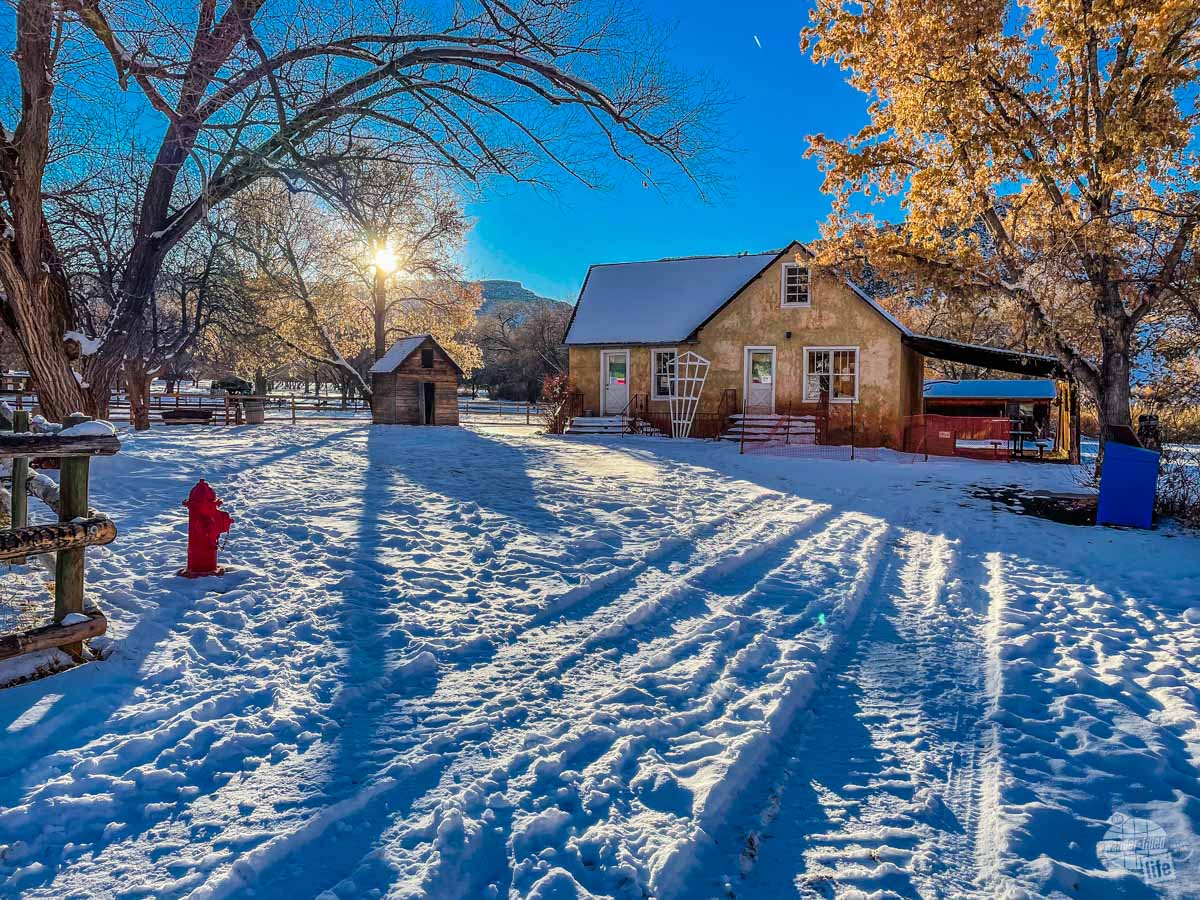
Further east from schoolhouse along UT 24 is the Petroglyph Panel and the Behunin Cabin.
While the Mormons were the first modern settlers in the area, people have lived in this area for more than a thousand years. The Fremont people, who predated today’s Ute, Paiute, Hopi, Navajo and Zuni tribes, long ago painted and carved images into the cliffs along the river. The Park Service built a boardwalk to allow visitors to see these ancient carvings.
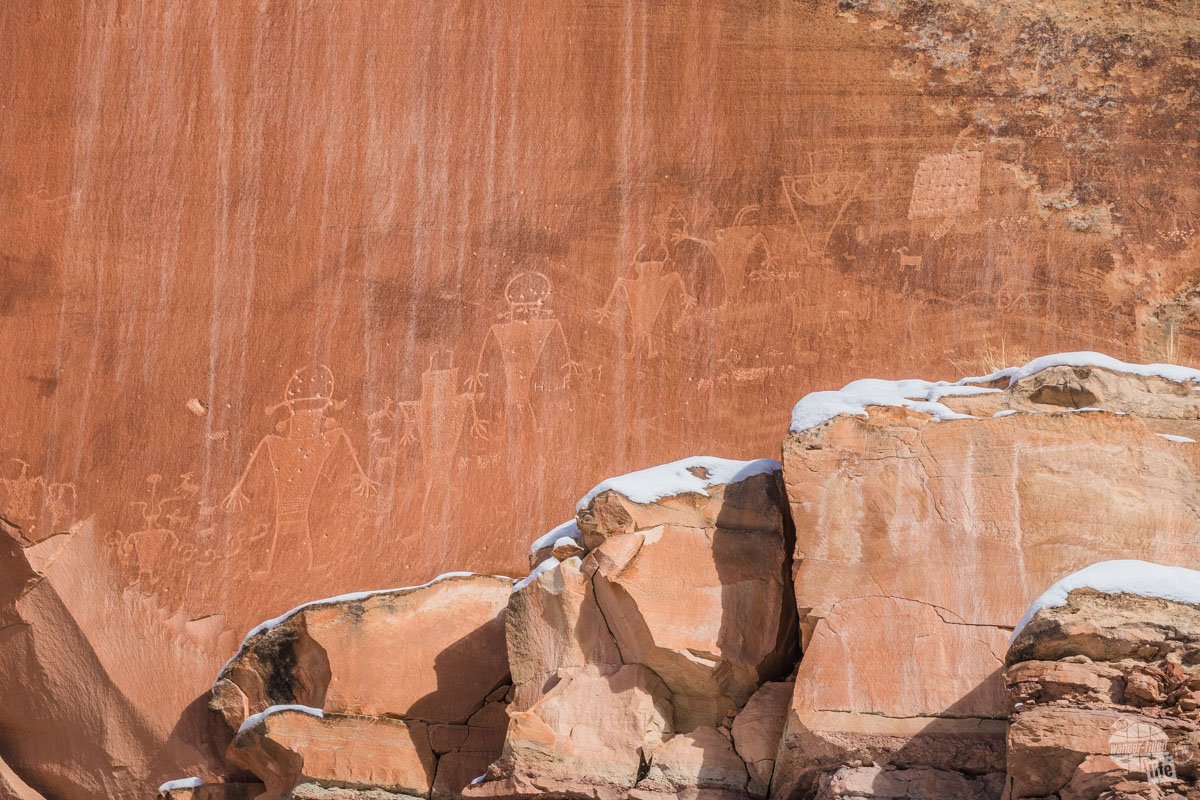
Further down the road is the Behunin Cabin, a small stone cabin just across from the Fremont River. Elijah Cutler Behunin and his family did not stay in this cabin long due to the frequent floods. How this family, which included 13 children, shared this tiny cabin beggars the imagination.
Drive the Scenic Drive
The Scenic Drive is an 8-mile paved road with a couple of dirt road spurs and several stops. I will be honest here: the road was closed for most of our visit due to snow. When it finally opened, it was about an hour or so before sunset. So, we did not spend nearly as much time on this road as we should have.
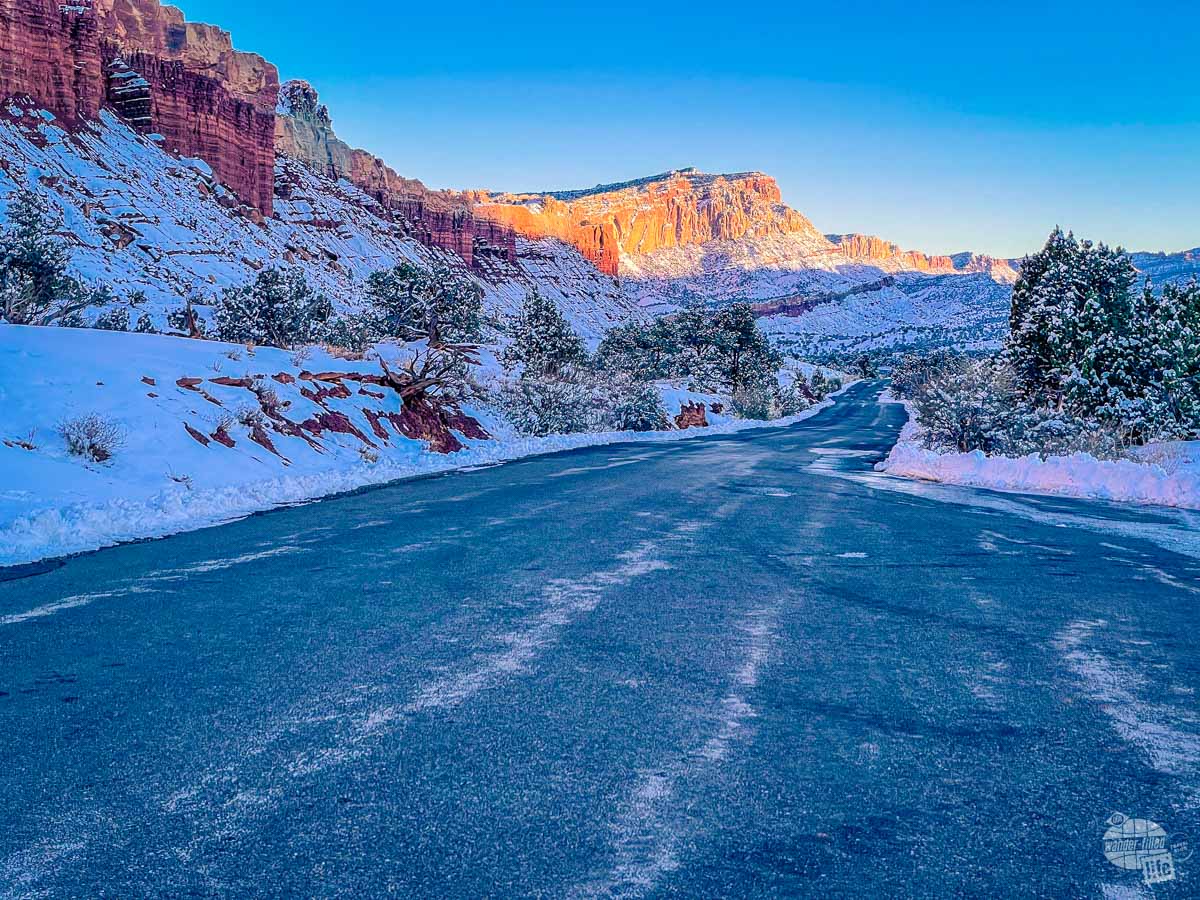
There are 11 stops along the road and the park website has a detailed guide to each stop. Still, the views are amazing and we can’t wait to go back and explore more. Due to the snow and setting sun, we did not drive the spur roads or really get a chance to enjoy the pullouts.
Explore the Backcountry on Unimproved Roads
There are several unimproved roads throughout the park that you can explore depending on your vehicle and road conditions. Indeed, one of the areas we drove through had plenty of Bentonite clay, which gets really slick and almost impassible in wet weather. We have encountered Bentonite clay before in Theodore Roosevelt National Park, so we were familiar with how bad it could get.
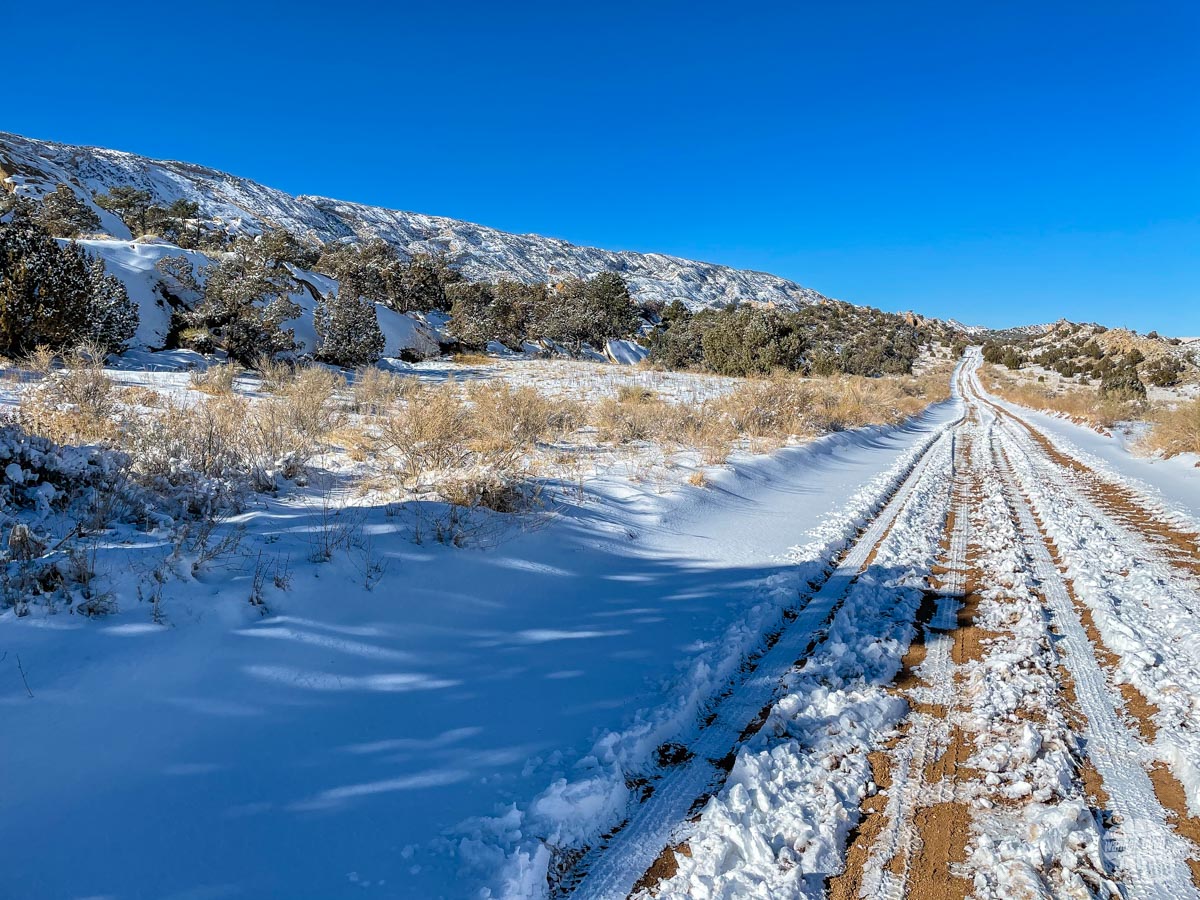
Indeed, the ranger we spoke to recommended against traveling on any of the dirt roads after the snow. The wet clay could make for impassible conditions. While we rely upon rangers for advice on travel conditions, we often find they are very conservative in their recommendations. We have found on several of our drives on unimproved roads (like River Road in Big Bend National Park and the Medano Pass Road in Great Sand Dunes National Park) that a basic four-wheel-drive vehicle can handle most conditions without difficulty.
That said, judge your own experience and capabilities conservatively. Help is typically a long way away.
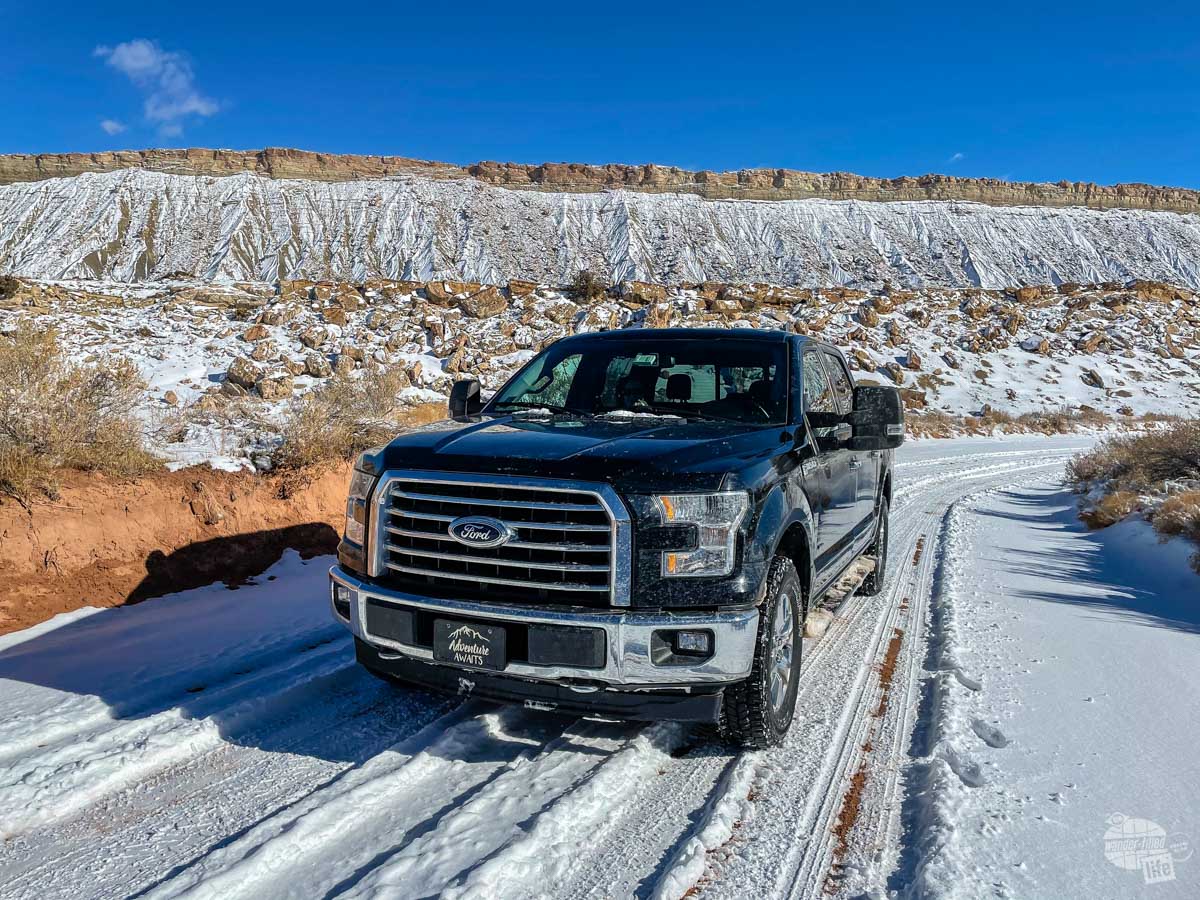
We decided not to drive the Cathedral Valley this time around. Boy, do I want to come back to spend a day driving this loop, including fording the Fremont River! Based upon my research, I wouldn’t want to do this ford in less than a high-clearance four-wheel-drive vehicle. While you can avoid fording the river, where’s the fun in that?
So instead, we decided to take the Notom-Bullfrog Road south along the Waterpocket Fold, the name for the southern part of Capitol Reef National Park.
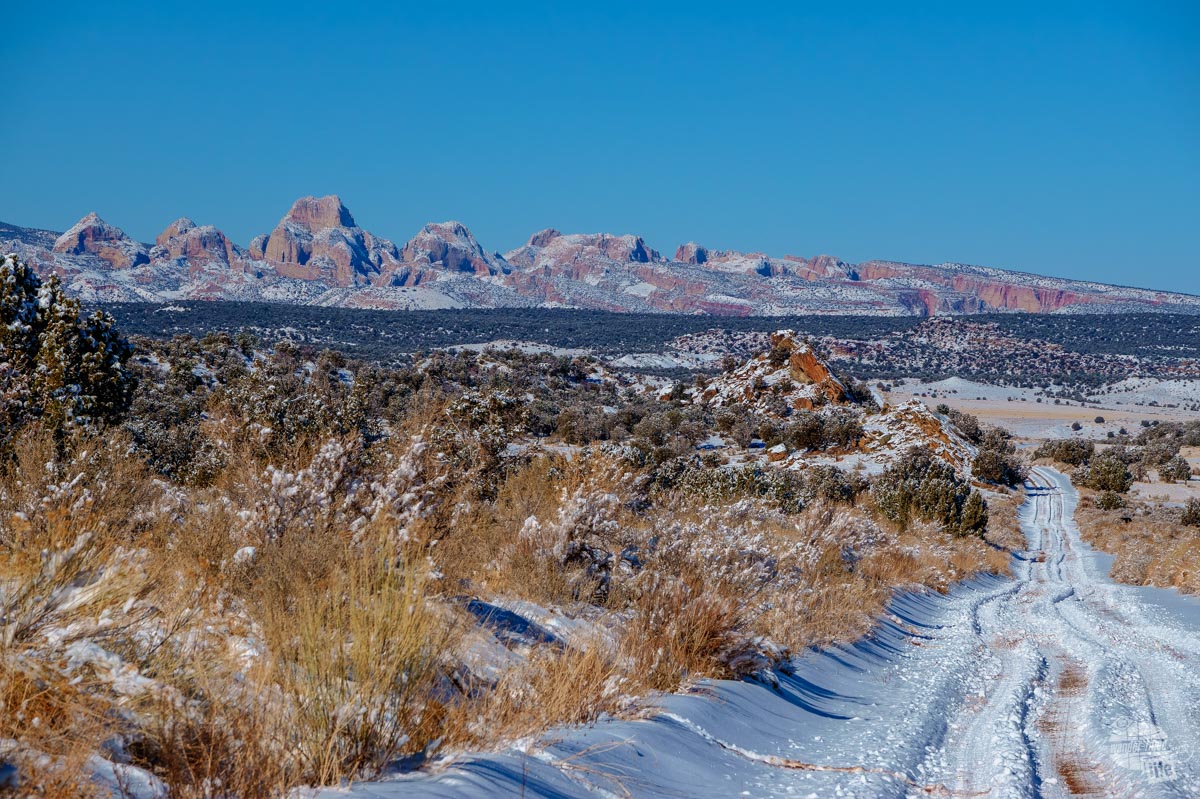
Driving the Notom-Bullfrog Road
Heading east then south along the eastern edge of the park, we explored 30 miles of snow-covered dirt road with gorgeous scenery everywhere we looked. This is the real benefit of visiting Capitol Reef National Park in the winter!
Based upon the recommendations of the ranger, we were originally planning on driving to the Cedar Mesa Campground. At that point, we planned on turning around but we found great conditions on the road, so we continued south. To be fair, the temperature was not nearly warm enough to melt the snow. In a couple of days, the road would have been a complete mess. But at this point, I felt comfortable with my and my truck’s capabilities.
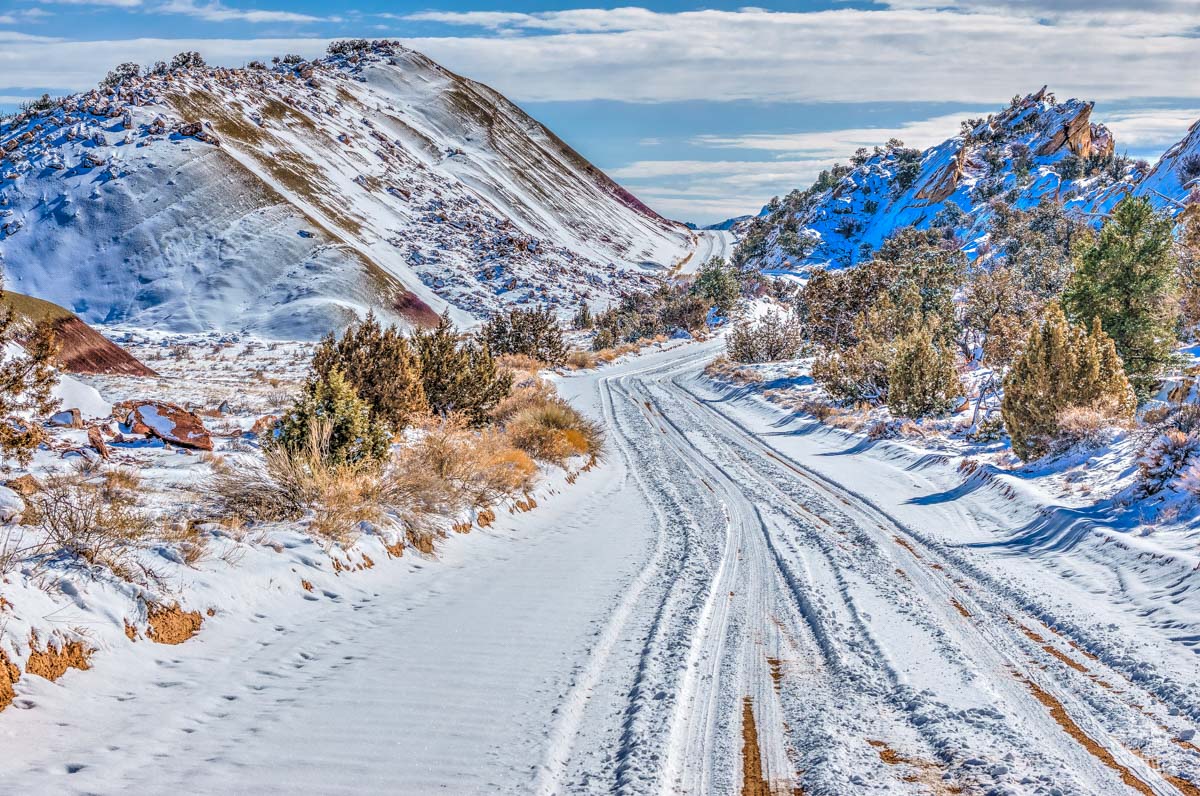
Heading through Strike Valley, with Bentonite clay hills to the left and the Waterpocket Fold to the right, was simply breathtaking in the winter. As we pushed south, we encountered only a few other drivers. For the most part, we had the road to ourselves.
We got to the Burr Trail Junction and decided not to try the switchbacks. They go up 800 feet in a half-mile! While we could see another driver heading up the road, discretion is the better part of valor on a snow-covered road!
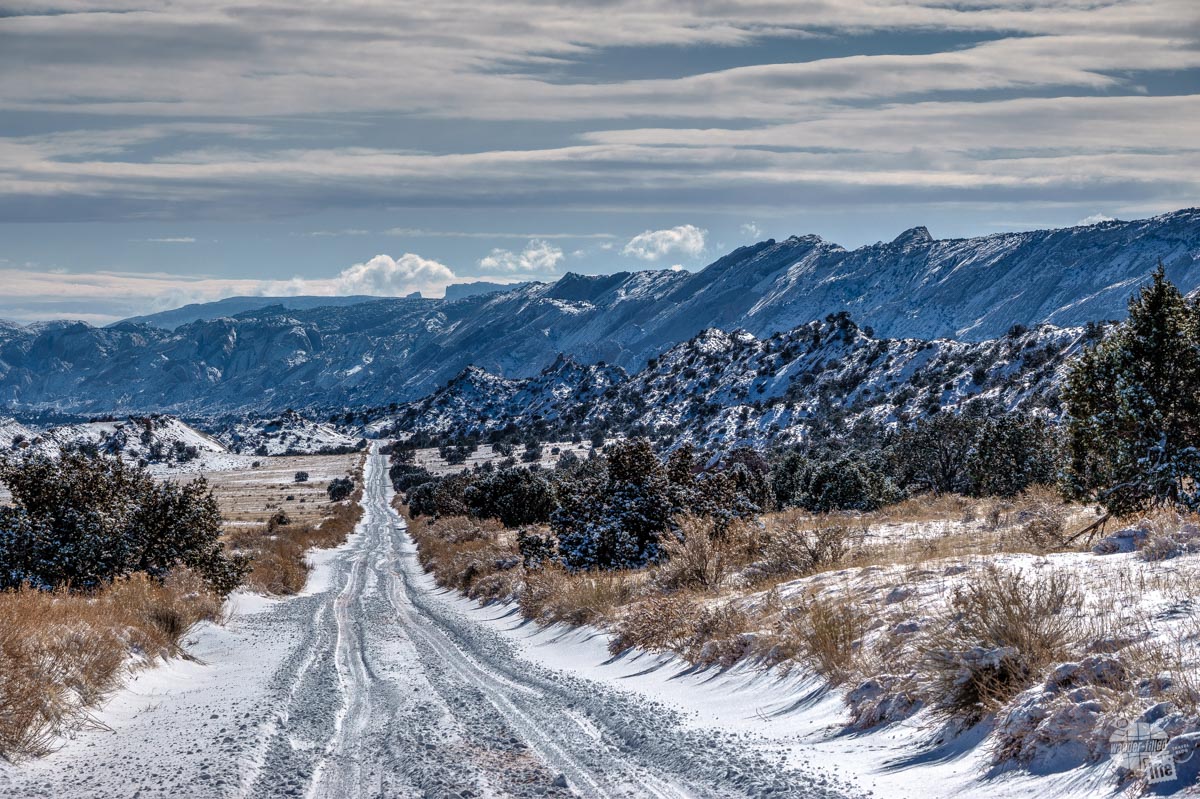
If it had not been for the snow, we would have done the “Loop the Fold” drive, which is a 124-mile loop through even more breathtaking scenery with a couple of additional roads to try. I can’t wait to return to do the full loop!
Still, what we got to drive and see was jaw-dropping. Throughout most of the drive, we just said, “Wow, this is so pretty!” over and over.
Hiking Capitol Reef National Park in the Winter
There are a ton of great day hikes in Capitol Reef National Park. The Park Service lists 15 day hikes near the Fruita area of various difficulties. There are even more trails in the Cathedral and Waterpocket Fold areas.
Unfortunately, I managed to hurt my foot slipping on some snow when leaving our hotel at Bryce Canyon National Park the previous day. So, we opted for one of the shorter, easy hikes and hiked the Grand Wash.
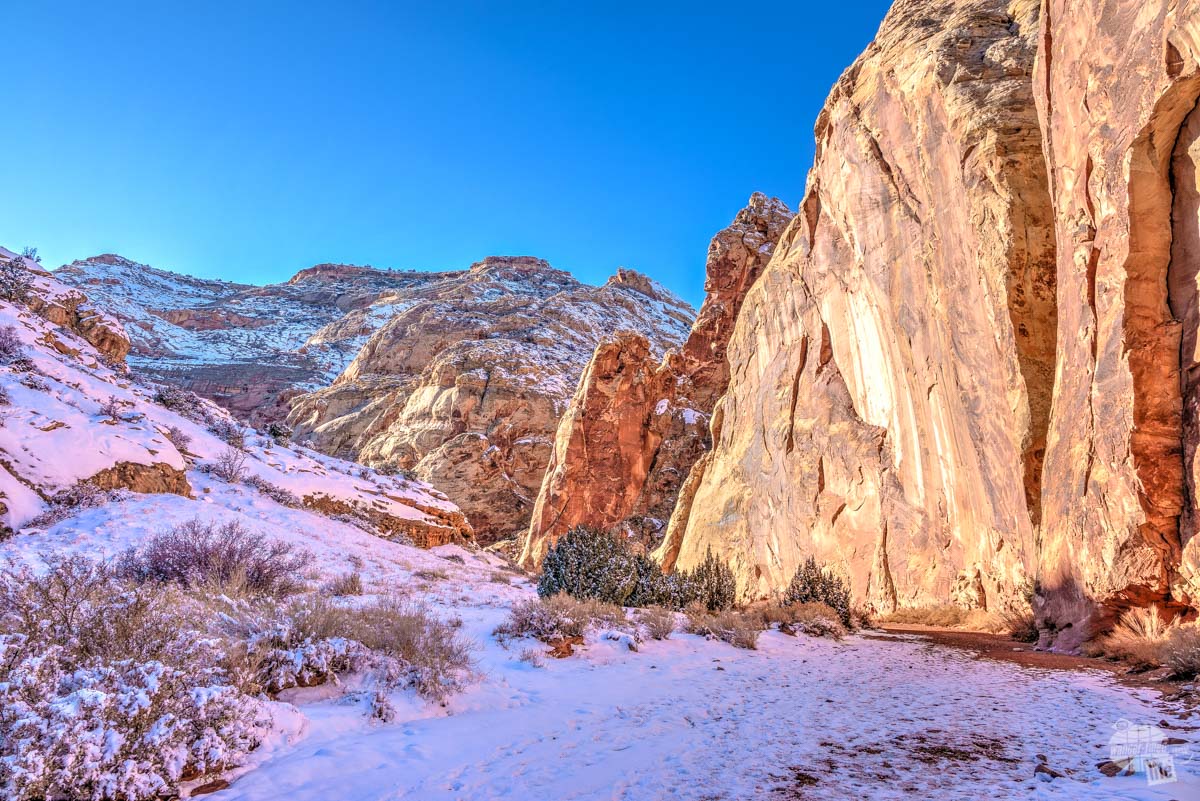
The Grand Wash is a 2.2-mile hike through a deep canyon that runs between UT 24 and the Grand Wash Road, an unpaved spur off the Scenic Drive.
Check out our 10 essentials for hiking here | Read more about hiking in the winter here
This hike takes you through a gorgeous, tight canyon with soaring cliffs all around. We started at the UT 24 trailhead and really enjoyed the trail. I really wish we could have done more hiking, particularly to Hickman Bridge or Cassidy Arch but I was not walking all that well on flat terrain. Hiking up snow-covered rocky trails was not a good idea.
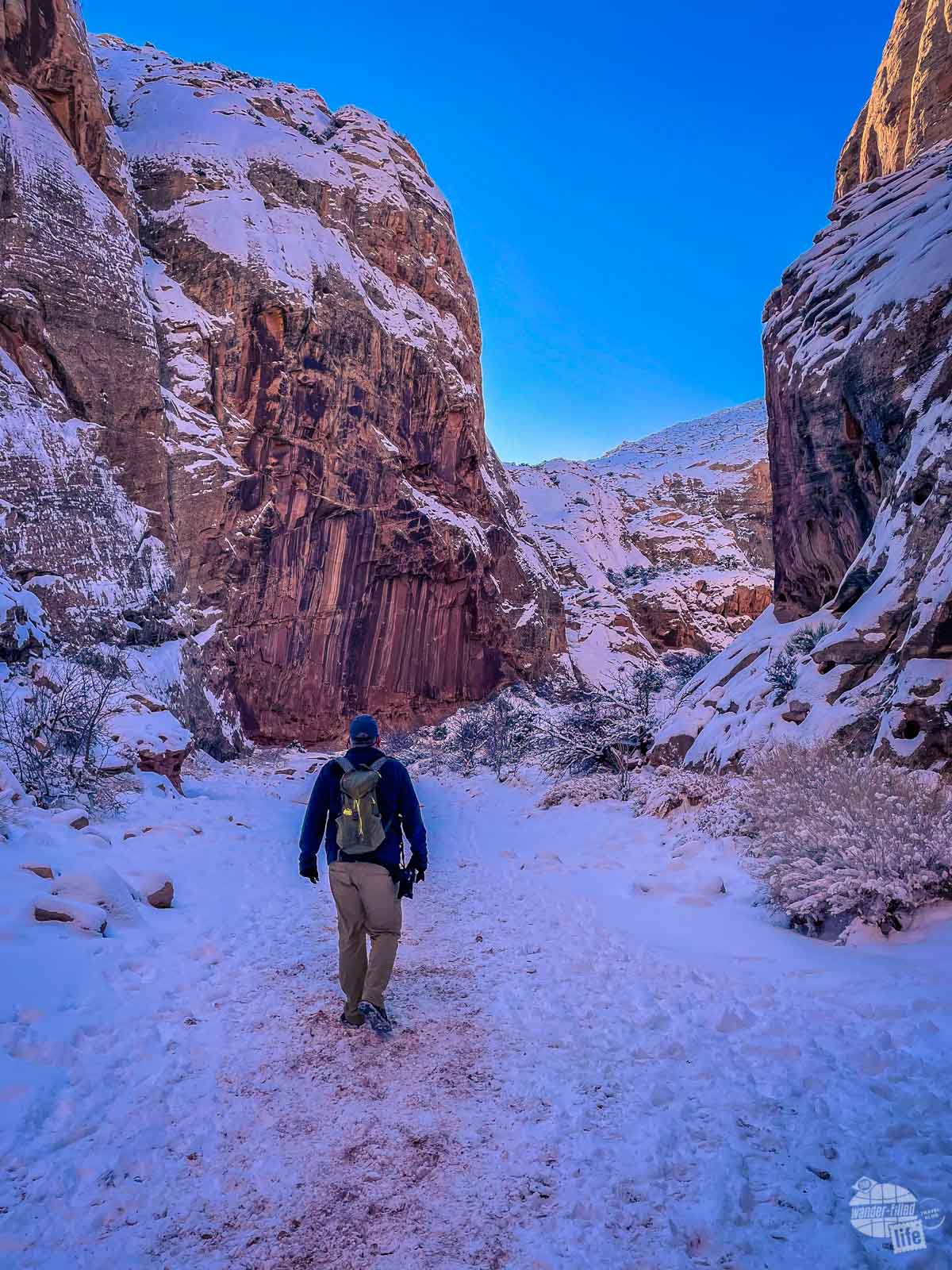
If it sounds like I am saying I really need to go back to Capitol Reef National Park, that’s because I really want to! There are several trails I want to hike in addition to the roads I want to explore.
Where to Stay and Eat at Capitol Reef National Park
One thing to note about visiting Capitol Reef National Park in the winter is there is not a ton open. When we visited, there were only a handful of hotels and restaurants open, partly due to the season and partly due to COVID-19.
Check out our tips for traveling safely during the pandemic.
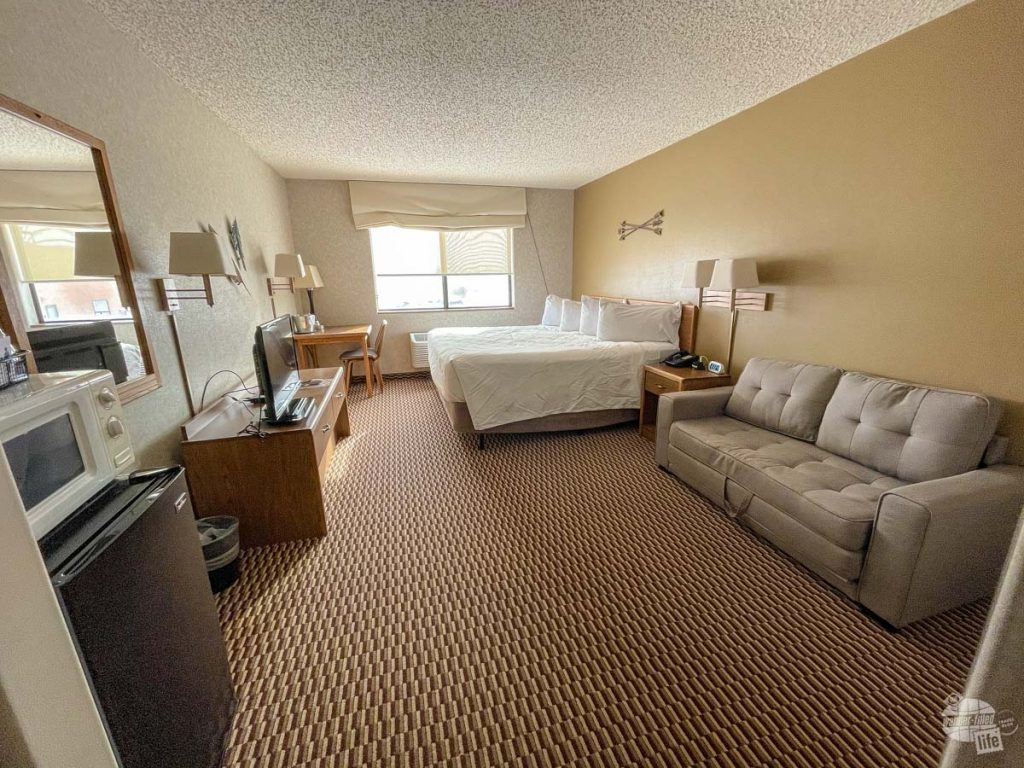
We stayed at the Red Sands Hotel in Torrey, the town closest to the park. The hotel was comfortable and the folks were quite friendly. There is a restaurant at the hotel but we ended up missing out on the one day they were open. We would stay here again if we returned in the winter.
Read Trip Advisor Reviews and Book a Hotel
While there are campgrounds in the park, there are no hookups for RVs. That said, we would love to camp at the Fruita Campground with our camper for a few days. There is a water fill and dump station to make camping without utilities that much easier.
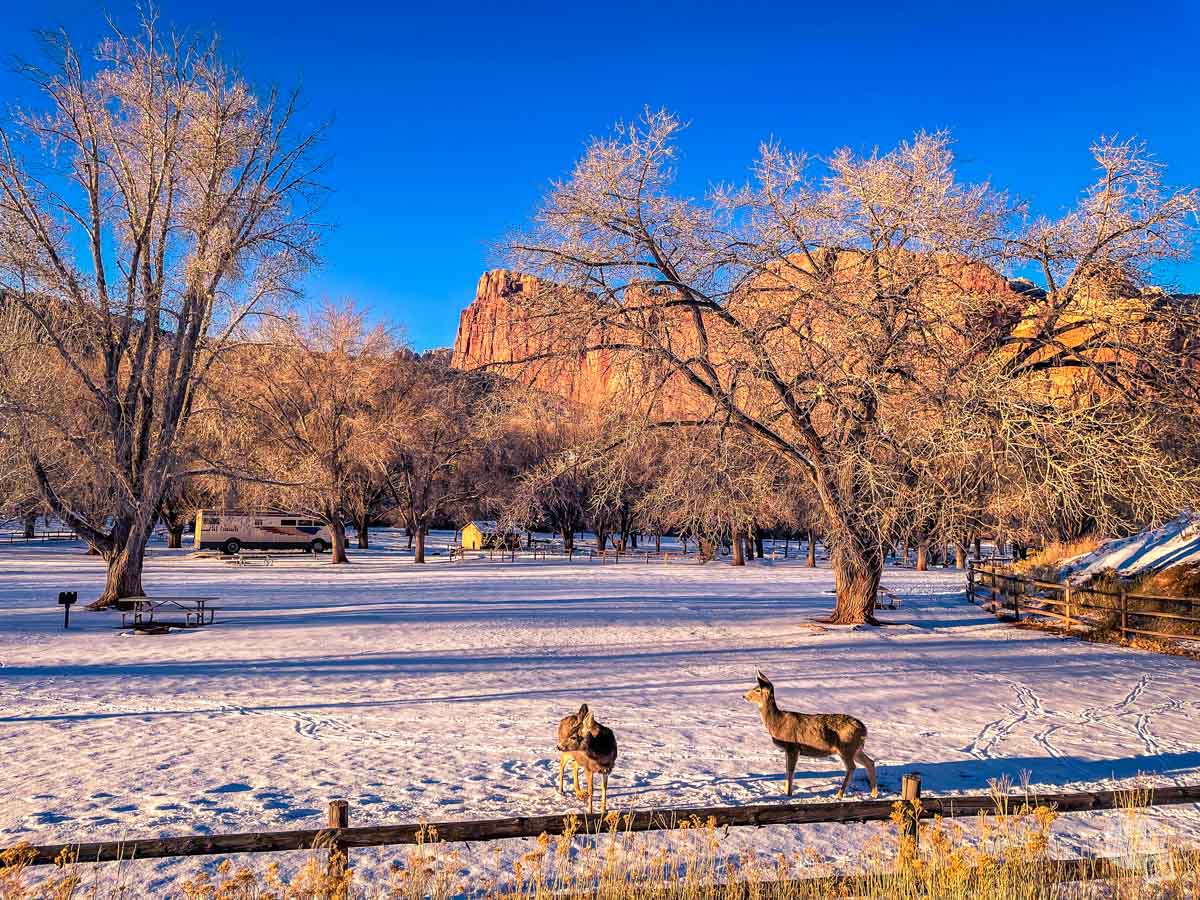
In terms of food, there is only one place we can recommend from our stay: Paizlee’s Grass Fed Beef. This little cafe is part of a cattle operation and that’s all they sell… beef.
We picked up dinner to take back to our room and had a socially-distanced breakfast at one of the two tables in the cafe. The limited menu makes for some really tasty entrees and we highly recommend stopping in for a bite.
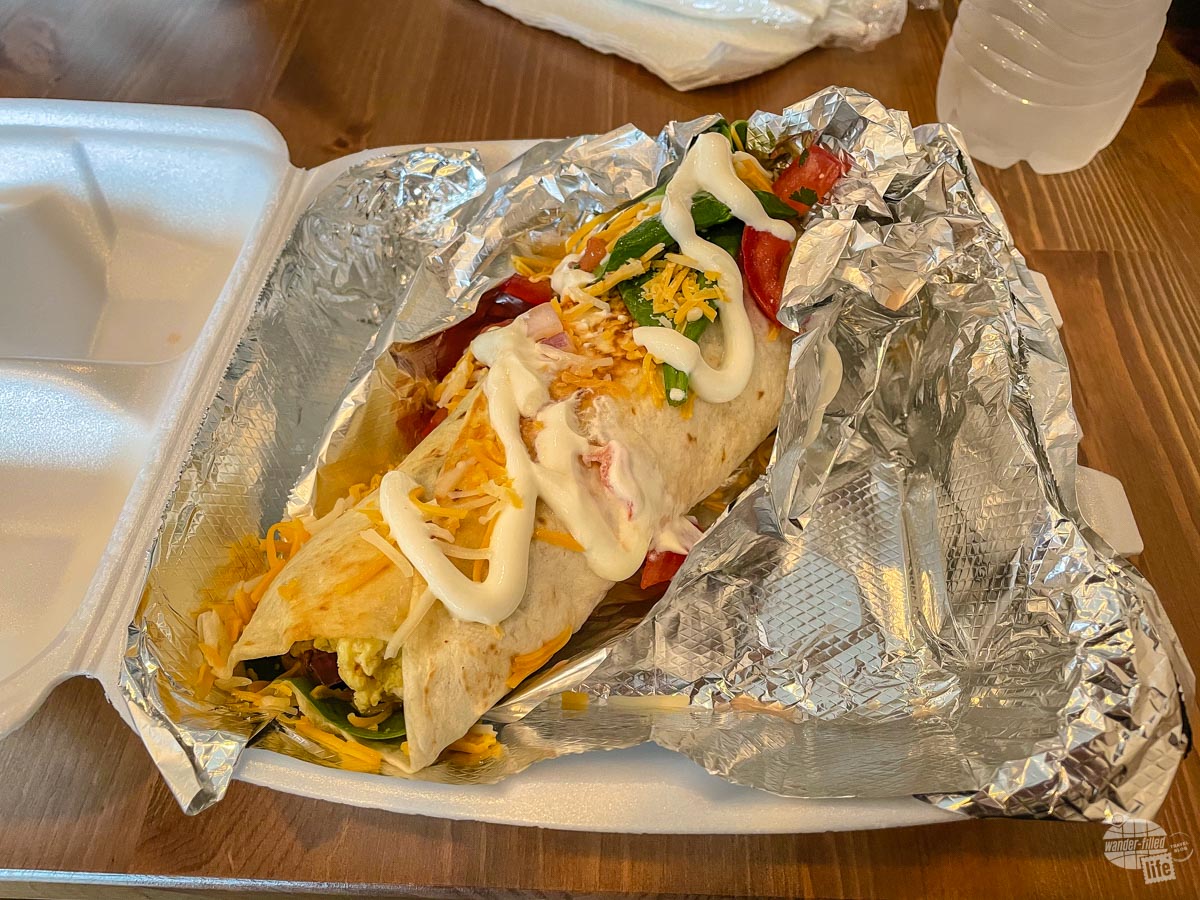
I am certain there are a bunch of other great restaurants in town but they were closed when we were there.
Final Thoughts on Capitol Reef National Park in the Winter
First and foremost, we loved our stay. We had a blast and seeing the desert landscape covered in snow was gorgeous. We would certainly do it again. For most folks, you can easily see the majority of Capitol Reef National Park in a day. You can explore the Fruita area, drive the Scenic Drive and hike a shorter trail in one day.
That said, being there when snow had covered everything was also pretty limiting. The park rarely gets snow in the winter and it definitely restricted what was open and available. In particular, not being able to drive the Scenic Drive or most of the unimproved roads really limited our experience.
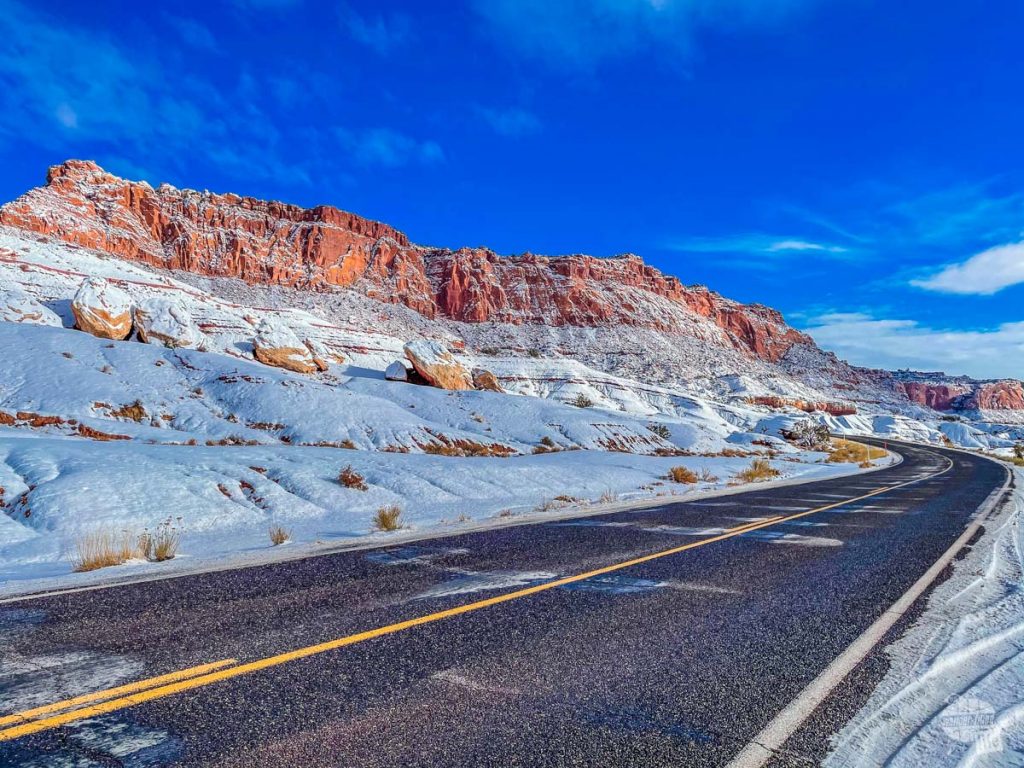
So, if I were to only visit this park once, I would come when it was dryer and most of the restaurants, etc., in town were open. I would also make sure to be there when the Gifford House was open. For us, we would likely spend several days really exploring this park.
Since we know we want to come back to visit Zion National Park in warmer weather and the North Rim of the Grand Canyon, we know we will be back to visit Capitol Reef National Park again.
Still, the park is amazing in the winter and the snow-covered cliffs were more than worth the trip!
Travel Resources
What do you use to find a flight?
We use Skyscanner to find deals on flights. Skyscanner has a great interface and compares tons of airlines for the best pricing and routing. That said, it does not always have every airline and some airlines will have better deals on their website. Still, Skyscanner is a great place to start.
Click here to search for a flight.
What do you use to find a hotel?
We typically stay at Hilton properties, so we use the Hilton website. You can find good Hilton Honors discounts or AAA discounts for a hotel there. We make great use of our free night certificates from our Hilton Honors American Express.
Click here to book a Hilton property.
If there are no Hilton properties available, we use TripAdvisor to read reviews and book the hotel. We find we can get the best price that way.
Click here to search for a hotel.
We recently partnered with Stay22 to add interactive maps to each of our destination posts. This will allow you to see a plethora of hotels and vacation rentals all in one responsive map of the area.
What if I need more space than I can get at a hotel?
We use Vrbo for the times when we have rented a cabin for a weekend getaway, like this cabin in Townsend, TN, or needed to rent a house for a large family vacation. We had a great experience with them in terms of refunding deposits when COVID hit and will continue to use them.
Click here to search for a vacation rental.
Who do you use for rental cars?
As a general rule, we book with Hertz for rental cars. We have had nothing but good experiences with them. Plus, we really like unlimited mileage and not worrying about crossing state lines. We have even rented from Hertz overseas in both Slovenia and Croatia.
Click here to book a rental car.
How about booking a cruise?
We have found some amazing prices for booking a cruise through Cruise Direct. We have saved a lot of money on our cruises compared to what we found elsewhere, making a last-minute Bahamas cruise even cheaper.
Click here to book a cruise.
What if I want to rent an RV?
We highly recommend Outdoorsy for RV rentals. We rented a camper van for a week to visit Rocky Mountain National Park for the elk rut and Custer State Park for the Buffalo Round-Up and had a blast. The program was easy to use and we really enjoyed the freedom of having a camper van for that trip.
Click here to rent an RV.
What do you use for booking tours?
We don’t often book tours. Typically, we like to do stuff on our own. That said, there are some experiences you can’t have any other way. So, when we do want to book a tour, we always check Viator first.
Click here to book a tour.
Do you use anything to get discounts on the road?
We make extensive use of both Good Sam and AAA on the road. Good Sam is normally regarded as a discount card for RVers at campgrounds and Camping World but anyone can use the 5 cents off a gallon at the pump at both Pilot and Flying J.
Click here to get a Good Sam membership.
We have had AAA as long as we have been married and it has more than paid for itself in discounts at hotels, aside from the peace of mind of having roadside assistance. Add in paper maps and the ability to get an international driver’s license and it is more than worth it for any traveler out there.
Click here to get a AAA membership.
